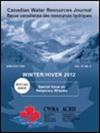Subwatershed-based lake and river routing products for hydrologic and land surface models applied over Canada
IF 0.9
4区 环境科学与生态学
Q3 WATER RESOURCES
引用次数: 6
Abstract
Abstract Lakes and reservoirs have critical impacts on hydrological, biogeochemical, and ecological processes, and they should be an essential component of regional-scale hydrological and eco-hydrological models. This is particularly important in Canada with its tens of thousands of lakes. Past large-scale hydrologic modelling efforts tend to either ignore the impacts of all lakes or explicitly simulate the behaviour of only the largest lakes in a watershed. This research derives a suite of Pan-Canadian subwatershed-based lake and river routing GIS products at multiple spatial resolutions (average catchment size ranges from 60 to 306 km2 while the number of lakes explicitly represented ranges from 11,000 to 87,000). These publicly available data products supply all the necessary hydrologic routing model inputs, including network topology, subwatershed geometry, channel characteristics (slope, length, roughness, and geometry), and lake characteristics (area, volume, and outlet description), and were derived primarily from the HydroLAKES, HydroBASINS and HydroSHEDS databases. All Water Survey of Canada streamflow gauging stations are used to define subwatershed outlets in the products. The routing product is used to inform a hydrologic routing model in the Raven hydrologic modelling framework. This is the first demonstration of Raven in routing-only mode. As a case study, the Hudson Bay drainage basin (∼40% of Canada) is simulated using GEM-Surf land surface model gridded runoff and recharge as inputs and includes more than 20,000 river reaches and more than 10,000 lakes explicitly represented at an hourly timestep. Uncalibrated streamflows compare reasonably well to measured streamflows at select locations. The sensitivity of the routing model prediction quality to the discretization level for represented lakes is evaluated and shows, for example, that ignoring multiple smaller lakes can have a significant impact on predictions.用于加拿大水文和地表模型的基于子流域的湖泊和河流路线产品
摘要湖泊和水库对水文、生物地球化学和生态过程具有重要影响,它们应该是区域尺度水文和生态水文模型的重要组成部分。这在拥有数以万计湖泊的加拿大尤为重要。过去的大规模水文建模工作往往忽略所有湖泊的影响,或者只明确模拟流域中最大湖泊的行为。这项研究得出了一套基于泛加拿大亚流域的湖泊和河流路线GIS产品,具有多个空间分辨率(平均集水区大小从60到306 km2,而明确表示的湖泊数量在11000至87000之间)。这些公开可用的数据产品提供了所有必要的水文路线模型输入,包括网络拓扑、子流域几何形状、河道特征(坡度、长度、粗糙度和几何形状)和湖泊特征(面积、体积和出水口描述),主要来源于HydroLAKES、HydroBASINS和HydroSHEDS数据库。加拿大水资源调查局的所有流量测量站都用于定义产品中的子流域出水口。路由产品用于为Raven水文建模框架中的水文路由模型提供信息。这是Raven在仅路由模式下的首次演示。作为一项案例研究,哈德逊湾流域(加拿大的40%)使用GEM Surf陆地表面模型网格径流和补给作为输入进行模拟,包括20000多个河段和10000多个湖泊,以每小时一个时间步长明确表示。未校准的流量与选定位置的测量流量相比相当好。评估了路由模型预测质量对所代表湖泊的离散化水平的敏感性,并表明,例如,忽略多个较小的湖泊可能会对预测产生重大影响。
本文章由计算机程序翻译,如有差异,请以英文原文为准。
求助全文
约1分钟内获得全文
求助全文
来源期刊

Canadian Water Resources Journal
WATER RESOURCES-
CiteScore
2.90
自引率
5.90%
发文量
17
审稿时长
>12 weeks
期刊介绍:
The Canadian Water Resources Journal accepts manuscripts in English or French and publishes abstracts in both official languages. Preference is given to manuscripts focusing on science and policy aspects of Canadian water management. Specifically, manuscripts should stimulate public awareness and understanding of Canada''s water resources, encourage recognition of the high priority of water as a resource, and provide new or increased knowledge on some aspect of Canada''s water.
The Canadian Water Resources Journal was first published in the fall of 1976 and it has grown in stature to be recognized as a quality and important publication in the water resources field.
 求助内容:
求助内容: 应助结果提醒方式:
应助结果提醒方式:


